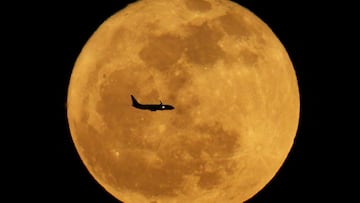Full Moon in July 2024: what time, when it occurs and how to see the Super Buck Moon
During the night of Sunday, July 21, we will be able to clearly observe the full moon in his most visible phase. It will also be on view the night before and the following night.

The “Super Buck Moon” is an astronomical phenomenon that occurs when the full moon in July coincides with the Moon’s closest approach to Earth in its elliptical orbit, a point known as perigee. During this event, the Moon appears larger and brighter in the night sky. The name Deer Moon comes from the traditions of Native American people, who observed that during this month male deer begin to develop their new velvet antlers, a crucial period in their life cycle.
The July #SuperMoon (Buck or #ThunderMoon) did not disappoint as it rose over #NYC 📸
— James M. Falletti, M.Ed. (@JamesFalletti) July 14, 2022
Full “Super” #Moon 🌕
Moon is 100% of Full
2022-07-13 9:20pm EST#Nikon #weather #NASA @MichelePowersWx @JGodynick @JamesGWeather @DaveCurren @WeatherGeoff @News12Weather @accuweather pic.twitter.com/gkjS8yhvgN
The term ‘Supermoon’ refers to any full moon that occurs near perigee, creating a spectacular sight due to its increased size and brightness. The Super Buck Moon symbolizes not only an impressive astronomical event, but also a connection with seasonal and natural changes that were important to indigenous communities, who depended on deer hunting for their survival.
This Sunday, July 21, we will be able to observe this phenomenon in the night skies. It will be especially notable because the moon will be in its full moon phase, reaching its maximum fullness and proximity to the Earth.
When and how to see the Super Buck Moon
According to the National Astronomical Observatory, the full moon will occur on Sunday, July 21, at 6:17 a.m. ET - note that it will be below the horizon at that time, so look towards the southeast after sunset to watch it rise into the sky in its brightest and most spectacular form.
Super ‘Full Buck’ Moon lights up night skies around the world pic.twitter.com/gTyzThsEN6
— The National (@TheNationalNews) July 4, 2023
The full moon occurs when the Earth is placed approximately between the Sun and the Moon, allowing the visible side of the Moon to be fully illuminated. In addition, it marks the middle of the lunar cycle, which lasts almost a month. Even so, both on the night of today, Saturday, July 20, and on the night of the 22nd, we will be able to observe the Supermoon with almost its entire surface illuminated. The full moon is best seen at dusk, when it begins to rise on the horizon, and in the early morning, when it reaches its highest point in the sky.
Related stories
Regarding where, almost any place away from the city and its light pollution will be a good place from which to observe the phenomenon. Obviously, in rural areas it can be seen better. Furthermore, there will be no need for telescopes or similar devices, although binoculars can help you better appreciate what is happening in the sky.
Curiously, this year’s Super Buck Moon coincides with the 55th anniversary of the Apollo 11 lunar landing (July 20, 1969) which makes the event even more significant. Noah Petro, chief of NASA’s Planetary Geology, Geophysics and Geochemistry Laboratory, said, “The first moon landing was in the afternoon on July 20, 1969, and then they did the moonwalk that night. There’s no better way to celebrate that than by going outside and looking at the full moon and toasting Neil [Armstrong], Buzz [Aldrin] and Michael Collins, and all the people who helped make Apollo 11 a reality 55 years ago.


Complete your personal details to comment